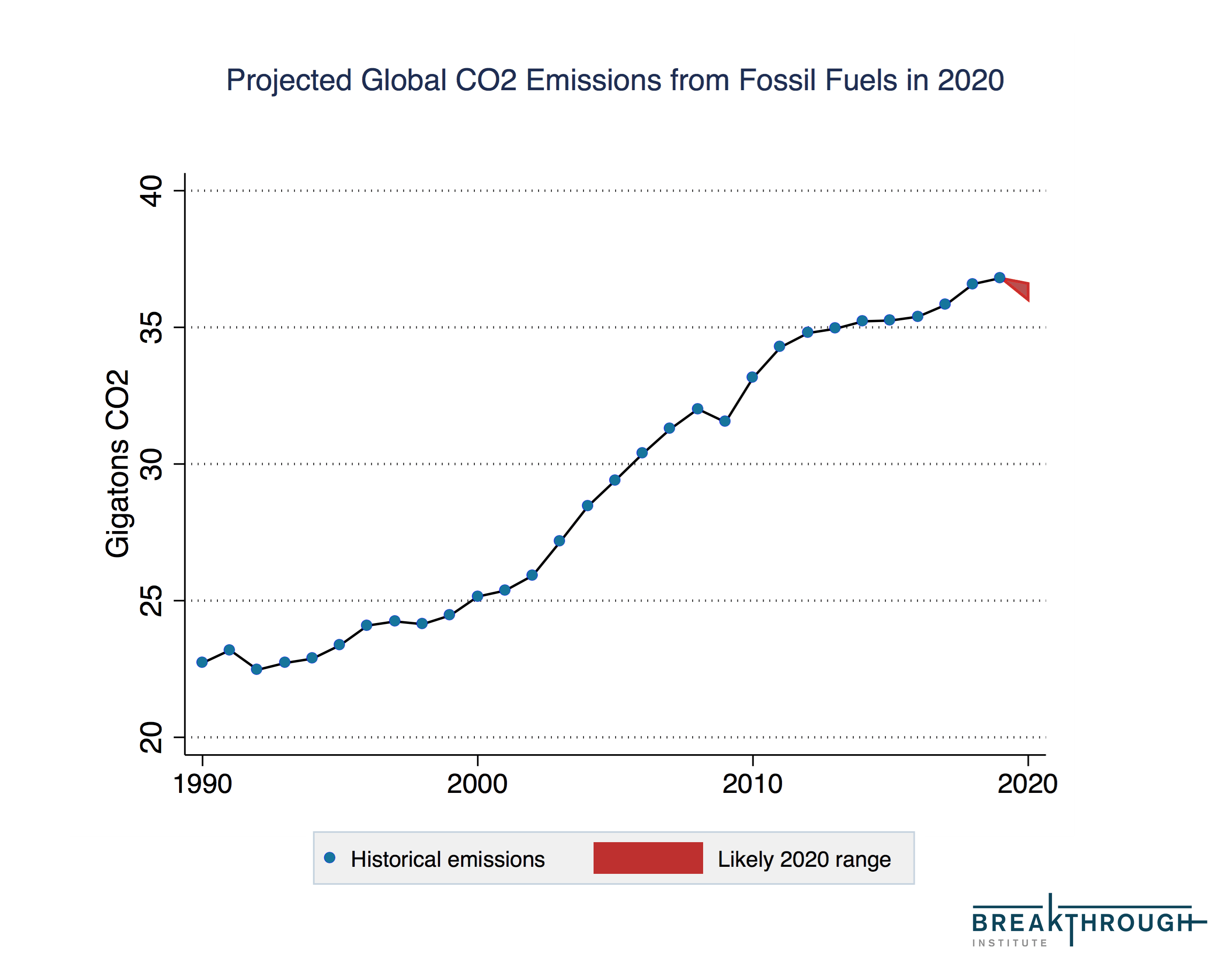There Is No Climate Silver Lining to COVID-19
The Global Pandemic May Barely Dent 2020 Emissions
-
-
Share
-
Share via Twitter -
Share via Facebook -
Share via Email
-
With the global economy grinding to a halt and many countries locking down their populations, it has been tempting to look for silver linings to the COVID-19 pandemic. False news of swans and dolphins returning to Venetian canals in the absence of waterborne traffic has gone massively viral, while reports that CO2 emissions from China fell by a quarter have also generated wide discussion. Could our social isolation measures at least be buying us more time when it comes to climate change?
The answer: probably not. While it appears almost certain that the pandemic will significantly impact global CO2 emissions in 2020, this effect will likely be neither strong enough nor prolonged enough to meaningfully alter our climate’s trajectory.
A number of GDP projections have recently been released that provide us with a range of scenarios for the pandemic's likely economic impact. These can be used to create a rough estimate of CO2 emissions changes, though many large uncertainties remain regarding the duration of the pandemic, the magnitude of the economic downturn, and the potential for a robust recovery later in 2020. Even so, our estimates indicate that the pandemic’s climate silver lining is vanishingly thin. Global emissions this year will probably fall by 0.5 to 2.2% from 2019 levels, assuming the global economy recovers in Q3 and Q4 2020.

Ultimately, particularly if past recessions are any guide, any reduction in emissions will prove fleeting, as global CO2 emissions will probably rise again once the crisis has passed. The social restrictions currently in place are not seen as tolerable in the long-term, and they — as well as the lid on emissions — will be lifted as soon as the situation allows. If anything, the pandemic will likely slow the world’s efforts to fight climate change as governments and industries pause investments in clean energy and infrastructure.
Yet once governments have brought the ongoing public health emergency under greater control and turn to large economic recovery and stimulus measures, those policies could generate important climate co-benefits by promoting clean technology and infrastructure. As the COVID-19 crisis appears likely to cost us more time to act on climate than it buys us, such needed opportunities should not be missed.
Large drops in GDP projected
Emissions declines will largely depend on the impact of COVID-19 on economic output. A diverse set of projections have come in from economists at JP Morgan, Goldman Sachs, the Federal Reserve Bank of St. Louis, and other institutions. While there is near consensus that we will face a general economic recession, analyses vary widely in how bad things will get. JP Morgan Chase & Co., for example, optimistically projects a 14% annualized drop in US GDP in Q2 of 2020, compared to the 50% annualized drop augured in an interview with the president of the Federal Reserve Bank of St. Louis.
While many of these financial projections are locked behind paid access, screenshots shared online from one of JP Morgan’s reports to clients provide the most complete breakdown of country-level changes currently available:

However, these numbers can be misleading as they are reported as quarter-on-quarter seasonally adjusted annualized rates (SAAR). This means that in Q1 of 2020, China’s GDP did not decline by 41% relative to the previous quarter. Rather, the rate of change in Q1 would result in a 41% GDP decline if sustained for the whole year. The actual decline in Q1 2020 GDP relative to Q4 2019 was about a quarter of the annualized rate, or about -10%. Economists also apply a seasonal adjustment procedure to account for regular variations like the impact of holidays on productivity.

Just as interesting as the predicted economic decline in the first half of 2020, however, is the seeming agreement that the global economy will rebound in the year’s second half. JP Morgan projects a sharp v-shaped response that might be overly optimistic, as past recessions have not seen such a dramatic spike upward in growth. At the same time, this recession is somewhat different in that it is a purposeful economic shutdown.
Impacts on global emissions
In the absence of the global pandemic, we would naively expect global emissions to increase around 1% in 2020 based on the trajectory over the past five years. Instead, the sharp reduction in economic activity in response to the ongoing crisis will almost certainly result in a drop, albeit modest, in global greenhouse emissions.
We considered two scenarios based on the abovementioned country-level JP Morgan GDP growth estimates. In the first scenario, countries see a sharp recovery from the economic downturn, with large growth in GDP in subsequent quarters making up for a large portion of the decline. In the second scenario, there is a more muted recovery, with GDP returning to pre-pandemic levels but not necessarily making up for lost time.
In the case where the pandemic’s effects wane and a sharp recovery occurs in the second half of 2020, global CO2 emissions would only decline around 0.5%, with much of the emissions decline in Q1 and Q2 erased by growing emissions in Q3 and Q4 as resurging economies go into overdrive. In the scenario where a recovery is more muted and economies only recover back to current levels in 2020, global CO2 emissions would decline by 2.2%. For comparison, the 2008 global financial crisis — and subsequent recession — resulted in a 1.5% decline in global emissions between 2008 and 2009.
It is also quite possible that economic declines could be much sharper than those projected by JP Morgan, as a number of other groups are suggesting might be the case in the US. At the same time, however, there is evidence of China’s economy ramping back up as domestic cases have been largely eliminated. In the absence of a second major outbreak it is likely that Chinese emissions will soon recover to pre-pandemic levels.
There is some indication that the effect on emissions might be more pronounced than the effect on GDP. In China, for example, a 15% to 20% decline occurred in coal use and air pollution during the shutdown despite only a 10% decline in quarterly GDP, though other indicators like traffic congestion only declined around 10%. These comparisons are also somewhat imperfect as the shutdown only started in late January rather than for the entire Q1 period.

As a thought experiment, if we assume that the carbon emissions impact is twice the reduction in GDP and recovery is muted, then global emissions would drop by 4.4% in 2020.
Of course, changes in emissions are difficult to predict given the large uncertainties in the duration and continued economic impact of the pandemic. Much larger declines in emissions are possible if economic shutdowns are prolonged, recovery is slow, and shutdown effects on CO2 emissions are larger than effects on GDP. Similarly, if the pandemic lasts well beyond Q2 2020 and/or reemerges in the fall, economic impacts and emission reductions could be much more severe.
Nevertheless, any reduction in emissions will likely prove short-lived. Past global economic slowdowns saw temporary reductions, but post-recovery emissions always bounced back where they would have been in the absence of a recession. And despite the likely emissions reduction for 2020, the COVID-19 pandemic may ultimately end up slowing down the global decarbonization trajectory, as efforts to develop, deploy, and improve low-carbon technologies have already been impacted by the economic downturn.
These factors mean that the ongoing global health emergency offers no climate silver lining. A transient, one-year fall in global CO2 emissions will offer no long-term respite from climate change once emissions rebound, and the pandemic’s economic impacts could hamper decarbonization’s progress. Relative to the parallel world in which the COVID-19 outbreak never occurred, our path to net zero emissions may very well have become more challenging, not less.

